Effect of Initial Microstructure on the Temperature Dependence of the Flow Stress and Deformation Microstructure under Uniaxial Compression of Ti-407
Abstract
1. Introduction
2. Materials and Methods
3. Results and Discussion
4. Conclusions
- (1)
- Compressive yield strength revealed a marked dependence on the initial microstructure. Yield strengths of furnace-cooled specimens were consistently lower throughout the test temperatures up to about 835 °C, where all initial microstructures converge at a yield strength of 14 MPa. This behavior is attributed to the higher α lath thickness of furnace-cooled specimens (1.7 ± 0.8 μm) in comparison with air-cooled and water-quenched samples (0.6 ± 0.3 μm and 0.5 ± 0.2 μm, respectively), as there are fewer inter-lath β ligaments per unit area to hinder dislocation motion.
- (2)
- The globular α fraction increased with temperature, reaching a maximum of 15–16% in the range of 815–830 °C, just below the Tβt. Deformation at temperatures below 815 °C produced predominantly elongated α phase, indicating that the strain magnitude solely is not enough to promote globularization of the α phase, but a certain temperature threshold below the Tβt must be reached.
- (3)
- Flow stress behavior revealed two temperature-dependent regimes based on the form of the true stress–true strain curves: (a) the low-temperature regime (750–815 °C) showing a peak stress at ε < 0.1 as a result of work hardening, followed by a softening stage, characterized by morphological changes in the alpha phase (kinking and then globularization) as well as flow localization, and (b) the high-temperature regime (830–910 °C), where flow stress remains virtually constant after reaching the peak stress, indicating a continuous competition of strain hardening and dynamic recovery in the deformed β grains.
Author Contributions
Funding
Data Availability Statement
Acknowledgments
Conflicts of Interest
References
- Henriques, V.A.R.; de Campos, P.P.; Cairo, C.A.A.; Bressiani, J.C. Production of titanium alloys for advanced aerospace systems by powder metallurgy. Mater. Res. 2005, 8, 443–446. [Google Scholar] [CrossRef]
- Hatt, O.; Lomas, Z.; Thomas, M.; Jackson, M. The effect of titanium alloy chemistry on machining induced tool crater wear characteristics. Wear 2018, 408–409, 200–207. [Google Scholar] [CrossRef]
- James, S.; Kosaka, Y.; Thomas, R.; Garratt, P. TIMETAL 407: A titanium alloy to enable cost reduction. In Proceedings of the 13th World Conference on Titanium, San Diego, CA, USA, 16–20 August 2015; John Wiley & Sons, Inc.: Hoboken, NJ, USA, 2016. [Google Scholar]
- Davey, W.; Bache, M.; Davies, H.; Thomas, M. Fatigue performance of the novel titanium alloy Timetal 407. MATEC Web Conf. 2018, 165, 4001. [Google Scholar] [CrossRef][Green Version]
- Sneddon, S.; Mulvihill, D.M.; Wielewski, E.; Dixon, M.; Rugg, D.; Li, P. Deformation and failure behavior of a titanium alloy Ti-407 with reduced aluminum content: A comparison with Ti-6Al-4V in tension and compression. Mater. Charact. 2021, 172, 110901. [Google Scholar] [CrossRef]
- Truax, D.; McMahon, C. Plastic behavior of titanium-aluminum alloys. Mater. Sci. Eng. 1974, 13, 125–139. [Google Scholar] [CrossRef]
- Kimura, A.; Nakamura, S.; Isogawa, S.; Matsubara, T.; Kimura, K.; Sato, Y. A Free Machining Titanium Alloy for Connecting Rods; SAE International: Pittsburgh, PA, USA, 1991. [Google Scholar]
- Singh, G.; da Fonseca, J.Q.; Preuss, M. Microstructure evolution and deformation texture during rolling of TIMETAL®407. Materialia 2020, 9, 100596. [Google Scholar] [CrossRef]
- Bache, M.; Davies, H.; Davey, W.; Thomas, M.; Berment-Parr, I. Microstructural control of fatigue behavior in a novel alpha+beta titanium alloy. Metals 2019, 9, 1200. [Google Scholar] [CrossRef]
- Murray, J. Calculation of the titanium-aluminum phase diagram. Metall. Trans. A 1988, 19, 243–247. [Google Scholar] [CrossRef]
- Singh, G.; Souza, P.M. Hot deformation behavior of a novel alpha+beta titanium alloy TIMETAL®407. J. Alloys Compd. 2023, 935, 1. [Google Scholar] [CrossRef]
- Dredge, C.; M’saoubi, R.; Thomas, B.; Hatt, O.; Thomas, M.; Jackson, M. A low-cost machinability approach to accelerate titanium alloy development. J. Eng. Manuf. 2021, 235, 1618–1632. [Google Scholar] [CrossRef]
- Semiatin, S.L.; Seetharaman, V.; Weiss, I. The thermomechanical processing of alpha/beta titanium alloys. JOM 1997, 49, 33–39. [Google Scholar] [CrossRef]
- Seshacharyulu, T.; Medeiros, S.; Frazier, W.; Prasad, Y. Microstructural mechanisms during hot working of commercial grade Ti-6Al-4V with lamellar starting structure. Mater. Sci. Eng. 2002, 325, 112–125. [Google Scholar] [CrossRef]
- Warchomicka, F.; Poletti, C.; Stockinger, M.; Henke, T. Microstructure evolution during hot deformation of Ti-6Al-4V double cone specimens. Int. J. Mater. Form 2010, 3, 215–218. [Google Scholar] [CrossRef]
- Zhang, J.; Li, X.; Xu, D.; Yang, R. Recent progress in the simulation of microstructure evolution in titanium alloys. Prog. Nat. Sci. Mater. Int. 2019, 29, 295–304. [Google Scholar] [CrossRef]
- Sun, J.; Qi, M.; Zhang, J.; Li, X.; Wang, H.; Ma, Y.; Xu, D.; Lei, J.; Yang, R. Formation mechanism of α lamellae during β→α transformation in polycrystalline dual-phase Ti alloys. J. Mater. Sci. Technol. 2021, 71, 98–108. [Google Scholar] [CrossRef]
- Durodola, J. Machine learning for design, phase transformation and mechanical properties of alloys. Prog. Mater. Sci. 2022, 123, 100797. [Google Scholar] [CrossRef]
- Mueller, T.; Kusne, A.G.; Ramprasad, R. Machine learning in materials science: Recent progress and emerging applications. Rev. Comput. Chem. 2016, 29, 186–273. [Google Scholar]
- Bignon, M.; Bertrand, E.; Rivera-Díaz-Del-Castillo, P.E.; Tancret, F. Martensite formation in titanium alloys: Crystallographic and compositional effects. J. Alloys Compd. 2021, 872, 159636. [Google Scholar] [CrossRef]
- Niu, Y.; Hong, Z.-Q.; Wang, Y.-Q.; Zhu, Y.-C. Machine learning-based beta transus temperature prediction for titanium alloys. J. Mater. Res. Technol. 2023, 23, 515–529. [Google Scholar] [CrossRef]
- Guo, K.; Yang, Z.; Yu, C.-H.; Buehler, M.J. Artificial intelligence and machine learning in design of mechanical materials. Mater. Horiz. 2021, 8, 1153–1172. [Google Scholar] [CrossRef]
- Banerjee, D.; Williams, J.C. Perspectives on titanium science and technology. Acta Mater. 2013, 61, 844–879. [Google Scholar] [CrossRef]
- Wang, X.; Zhan, M.; Gao, P.; Ma, P.; Yang, K.; Lei, Y.; Li, Z. Deformation mode dependent mechanism and kinetics of dynamic recrystallization in hot working of titanium alloy. Mater. Sci. Eng. A 2022, 772, 138804. [Google Scholar] [CrossRef]
- Tarín, P.; Gualo, A.; Simón, A.G.; Piris, N.M.; Badía, J.M. Study of alpha-beta transformation in Ti-6Al-4V-ELI. Mechanical and microstructural characteristics. Mater. Sci. Forum 2010, 638–642, 712–717. [Google Scholar] [CrossRef]
- Ding, C.; Li, X.; Zhu, H.-Y.; Chen, F.-W.; Li, F.; Chang, H. Microstructure evolution and phase transformation kinetics of low cost Ti-35421 titanium alloy during continuous heating. J. Mater. Res. Technol. 2021, 14, 620–630. [Google Scholar] [CrossRef]
- Yu, H.; Li, W.; Zou, H.; Li, S.; Zhai, T.; Liu, L. Study on Non-Isothermal Transformation of Ti-6Al-4V in Solution Heating Stage. Metals 2019, 9, 968. [Google Scholar] [CrossRef]
- Gao, P.; Fu, M.; Zhan, M.; Lei, Z.; Li, Y. Deformation behavior and microstructure evolution of titanium alloys with lamellar microstructure in hot working process: A review. J. Mater. Sci. Technol. 2020, 39, 56–73. [Google Scholar] [CrossRef]
- Park, C.; Won, J.W.; Park, J.-W.; Semiatin, S.L.; Lee, C.S. Mechanisms and kinetics of static spheroidization of hot-worked Ti-6Al-2Sn-4Zr-2Mo-0.1Si with a lamellar microstructure. Metall. Mater. Trans. A 2012, 43, 977–985. [Google Scholar] [CrossRef]
- Lindwall, G.; Wang, P.; Kattner, U.R.; Campbell, C.E. The effect of oxygen on phase equilibria in the Ti-V system: Impacts on the AM processing of Ti alloys. J. Mater. 2018, 70, 1692–1705. [Google Scholar] [CrossRef]
- Joshi, V.A. Titanium Alloys: An Atlas of Structures and Fracture Features; CRC Press: Boca Raton, FL, USA, 2006. [Google Scholar]
- Feng, Z.; Yang, Y.; Xu, Z.; Shi, Q. Effect of martensitic transformation on elastic modulus anisotropy of Ti-6Al-4V alloy. Mater. Res. 2018, 21, 1–8. [Google Scholar] [CrossRef]
- Feng, S.; Jinshan, L.; Hongchao, K.; Wenzhong, L.; Xianghong, L.; Yong, F. Phase transformation during the continuous cooling in near alpha titanium alloy Ti60. Rare Met. Mater. Eng. 2015, 44, 848–853. [Google Scholar] [CrossRef]
- Zhang, W.; Ding, H.; Zhao, J.; Yang, B.; Yang, W. Hot deformation behavior and processing maps of Ti-6Al-4V alloy with starting fully lamellar structure. J. Mater. Res. 2018, 33, 3677–3688. [Google Scholar] [CrossRef]
- Perumal, B.; Rist, M.A.; Gungor, S.; Brooks, J.W.; Fitzpatrick, M.E. The effect of hot deformation parameters on microstructure evolution of the alpha-phase in Ti-6Al-4V. Metall. Mater. Trans. A 2016, 47, 4128–4136. [Google Scholar] [CrossRef]
- Zhang, J.; Li, H.; Zhan, M. Review on globularization of titanium alloy with lamellar colony. Manufacturing 2020, 7, 18. [Google Scholar] [CrossRef]
- Guo, B.; Liu, Y.; Jonas, J.J. Dynamic transformation of two-phase titanium alloys in stable and unstable states. Metall. Mater. Trans. A 2019, 50, 4502–4505. [Google Scholar] [CrossRef]
- Wu, F.; Xu, W.; Jin, X.; Zhong, X.; Wan, X.; Shan, D.; Guo, B. Study on hot deformation behavior and microstructure evolution of Ti-55 high temperature titanium alloy. Metals 2017, 7, 319. [Google Scholar] [CrossRef]
- Wang, L.; Fan, X.; Zhan, M.; Jiang, X.; Liang, Y.; Zheng, H.; Liang, W. Revisiting the lamellar globularization behavior of a two-phase titanium from the perspective of deformation modes. J. Mater. Process. Technol. 2021, 289, 116963. [Google Scholar] [CrossRef]
- Ji, R.; Zhu, K.; Zhang, H.; Luo, H.; Mao, J. Microstructure evolution, mechanical response and strengthening models for TA15 titanium alloy during thermal processes: A brief review. J. Mater. Res. Technol. 2024, 28, 1644–1656. [Google Scholar] [CrossRef]
- Yan, Z.; Liu, H.; Dai, X.; Li, L.; Zhang, Z.; Wang, Q.; Xue, Y. Effect of multi-pass cooling compression and subsequent heat treatment on microstructural and mechanical evolution of TC4 alloys. J. Mater. Res. Technol. 2023, 23, 3137–3150. [Google Scholar] [CrossRef]
- Ge, J.; Zhan, X.; Li, C.; Zhang, X.; Zhou, K. Dynamic spheroidization mechanism and Its orientation dependence of Ti-6Al-2Mo-2V-1Fe alloy during subtransus hot deformation. Materials 2023, 16, 5752. [Google Scholar] [CrossRef]
- Aguirre, J.; Erice, B.; Arrese, P.; Otegi, N.; Galdos, L. Effect of near beta-transus forging parameters on the mechanical and microstructural properties of Ti-6Al-4V–Application to hammer forging. Mater. Res. Proc. 2023, 28, 675–682. [Google Scholar]
- Zhao, Z.; Zhang, B.H.; Sun, H.; Wang, Q.J.; Liu, J.R.; Yang, R. Influence of globularization process on local texture evolution of a near-α titanium alloy with a transformed microstructure. Metall. Mater. Trans. A 2023, 54, 2849–2857. [Google Scholar] [CrossRef]
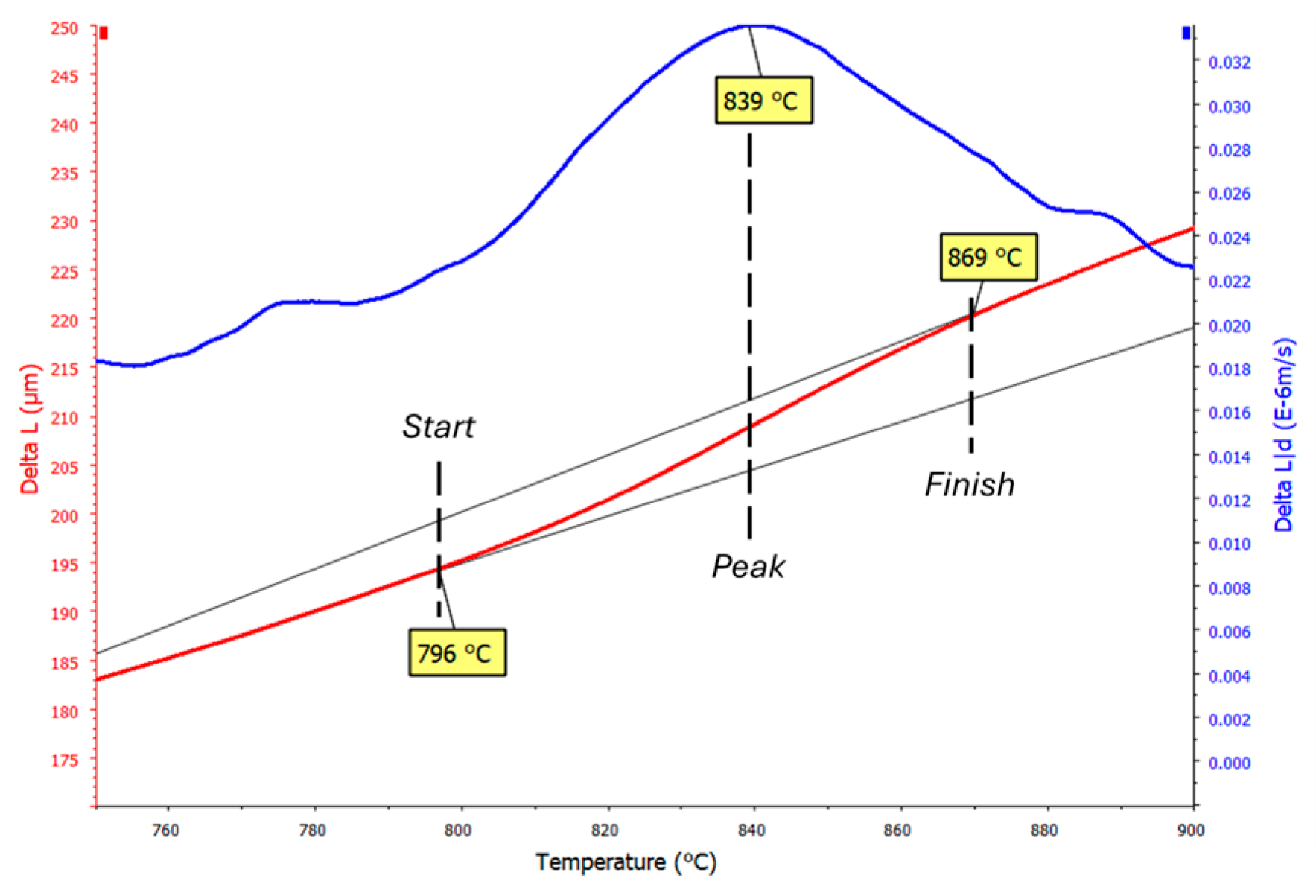
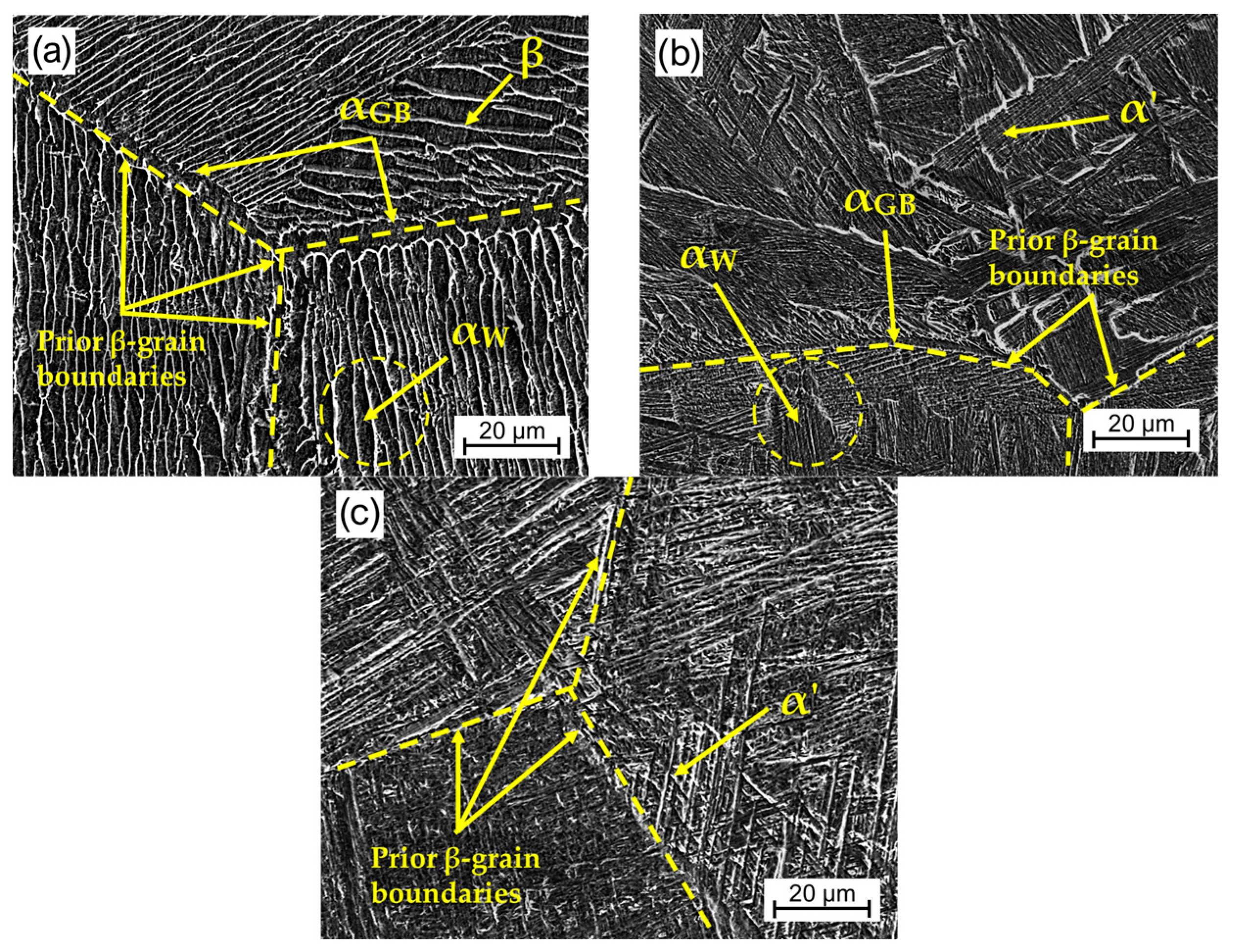
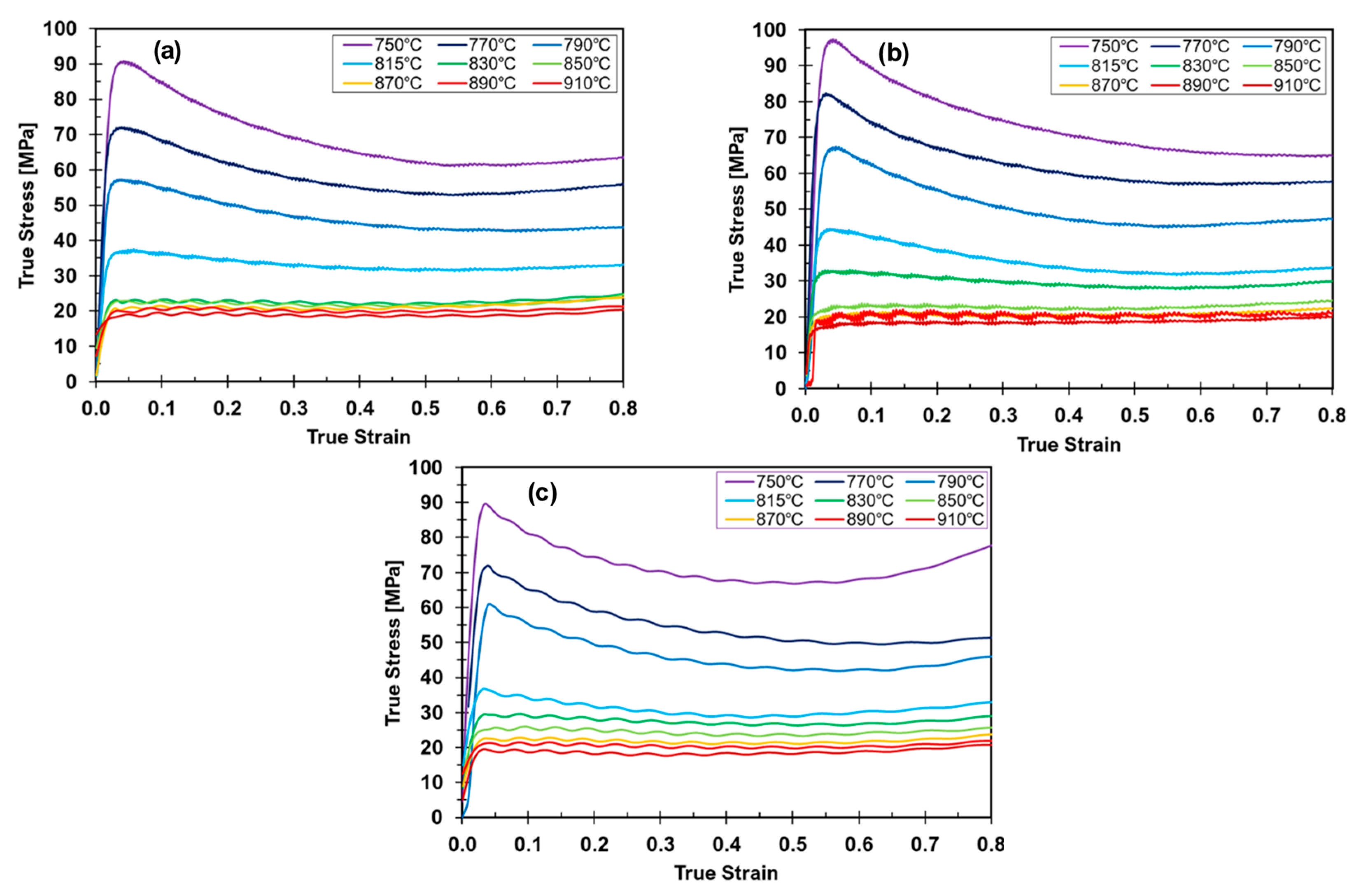

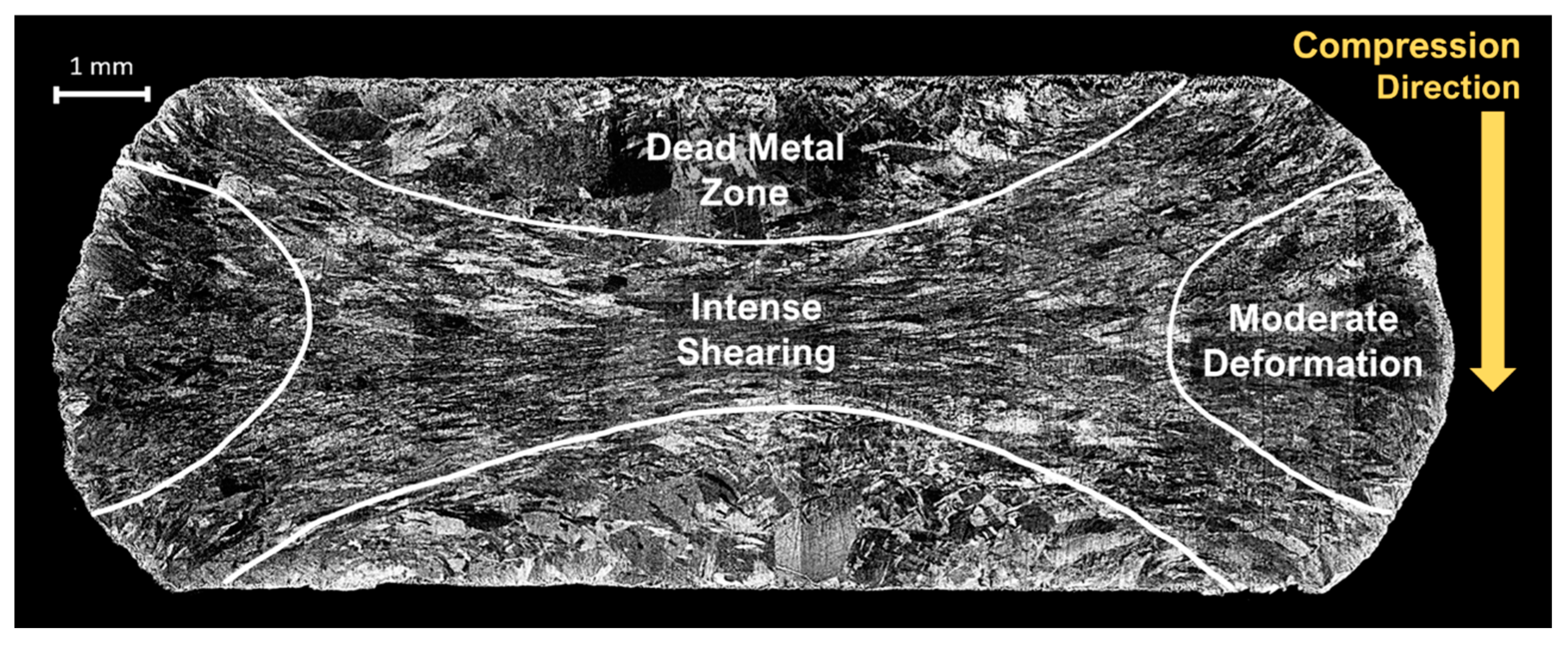
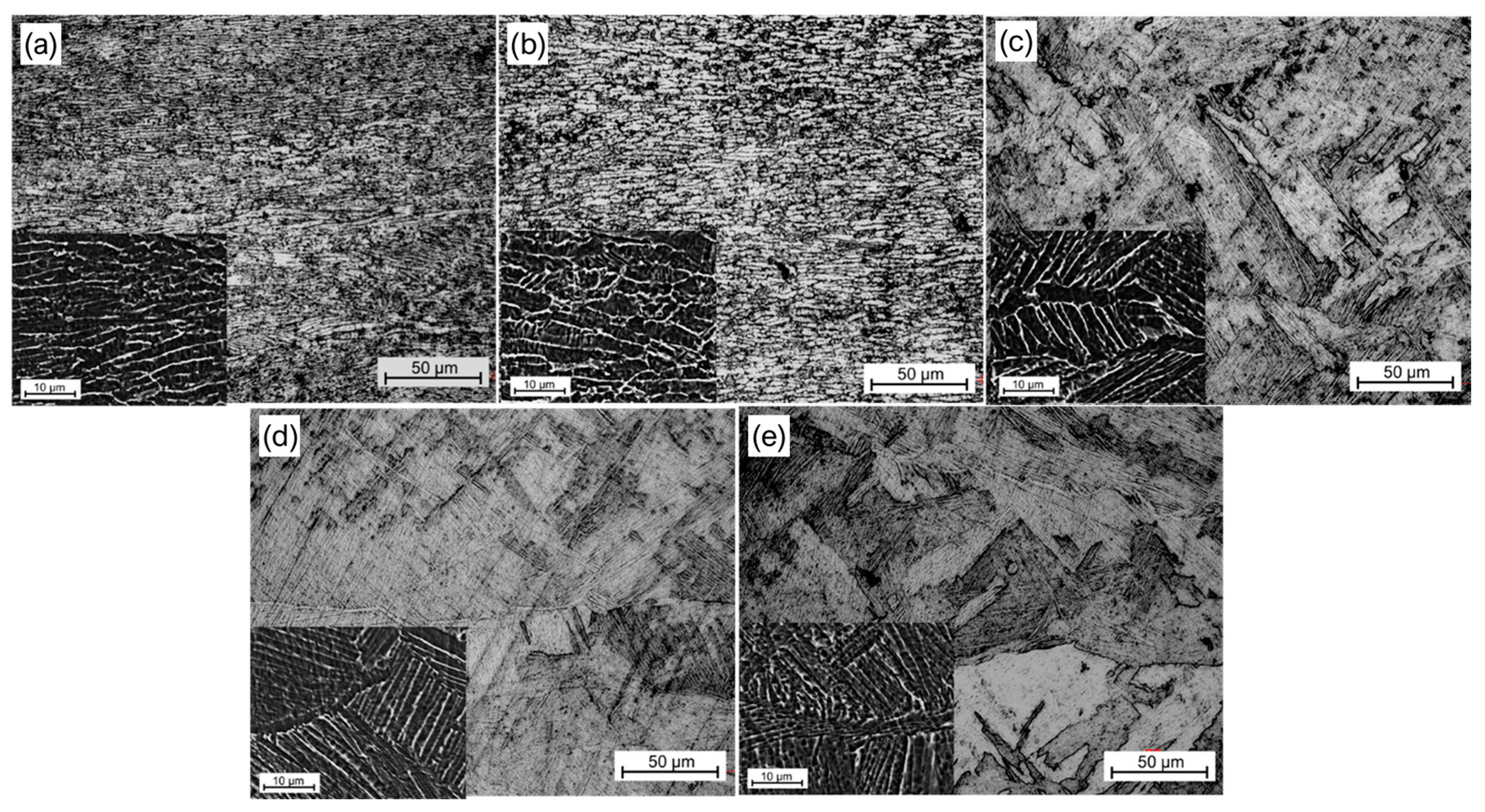



| V | Al | Si | Fe | O | C | N | Ti |
|---|---|---|---|---|---|---|---|
| 3.6 | 0.85 | 0.21 | 0.26 | 0.15 | <0.03 | <0.008 | Bal. |
| Furnace Cool | Air Cool | Water Quench | |
|---|---|---|---|
| α lath thickness (μm) | 1.7 ± 0.8 | 0.6 ± 0.3 | 0.5 ± 0.2 |
| % primary α | 82 | 70 | 65 |
Disclaimer/Publisher’s Note: The statements, opinions and data contained in all publications are solely those of the individual author(s) and contributor(s) and not of MDPI and/or the editor(s). MDPI and/or the editor(s) disclaim responsibility for any injury to people or property resulting from any ideas, methods, instructions or products referred to in the content. |
© 2024 by the authors. Licensee MDPI, Basel, Switzerland. This article is an open access article distributed under the terms and conditions of the Creative Commons Attribution (CC BY) license (https://creativecommons.org/licenses/by/4.0/).
Share and Cite
Barboza, L.; López, E.; Guajardo, H.; Salinas, A. Effect of Initial Microstructure on the Temperature Dependence of the Flow Stress and Deformation Microstructure under Uniaxial Compression of Ti-407. Metals 2024, 14, 505. https://doi.org/10.3390/met14050505
Barboza L, López E, Guajardo H, Salinas A. Effect of Initial Microstructure on the Temperature Dependence of the Flow Stress and Deformation Microstructure under Uniaxial Compression of Ti-407. Metals. 2024; 14(5):505. https://doi.org/10.3390/met14050505
Chicago/Turabian StyleBarboza, Luis, Enrique López, Hugo Guajardo, and Armando Salinas. 2024. "Effect of Initial Microstructure on the Temperature Dependence of the Flow Stress and Deformation Microstructure under Uniaxial Compression of Ti-407" Metals 14, no. 5: 505. https://doi.org/10.3390/met14050505
APA StyleBarboza, L., López, E., Guajardo, H., & Salinas, A. (2024). Effect of Initial Microstructure on the Temperature Dependence of the Flow Stress and Deformation Microstructure under Uniaxial Compression of Ti-407. Metals, 14(5), 505. https://doi.org/10.3390/met14050505







